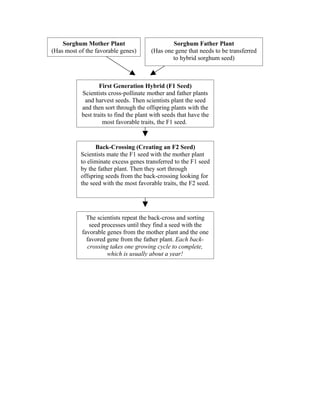
Hybridization Story Diagram Kastanek
- 1. Sorghum Mother Plant Sorghum Father Plant (Has most of the favorable genes) (Has one gene that needs to be transferred to hybrid sorghum seed) First Generation Hybrid (F1 Seed) Scientists cross-pollinate mother and father plants and harvest seeds. Then scientists plant the seed and then sort through the offspring plants with the best traits to find the plant with seeds that have the most favorable traits, the F1 seed. Back-Crossing (Creating an F2 Seed) Scientists mate the F1 seed with the mother plant to eliminate excess genes transferred to the F1 seed by the father plant. Then they sort through offspring seeds from the back-crossing looking for the seed with the most favorable traits, the F2 seed. The scientists repeat the back-cross and sorting seed processes until they find a seed with the favorable genes from the mother plant and the one favored gene from the father plant. Each back- crossing takes one growing cycle to complete, which is usually about a year!